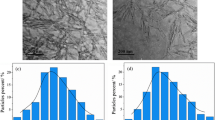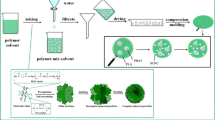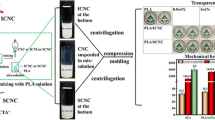Abstract
A novel biomimetic protein-resistant modifier based on cellulose-based polymeric liquid crystals was described (PLCs). Two types of PLCs of propyl hydroxypropyl cellulose ester (PPC) and octyl hydroxypropyl cellulose ester (OPC) were prepared by esterification from hydroxypropyl cellulose, and then were mixed with polyvinyl chloride and polyurethane to obtain composite films by solution casting, respectively. The surface morphology of PLCs and their composite films were characterized by polarized optical microscopy (POM) and scanning electron microscopy (SEM), suggesting the existence of microdomain separation with fingerprint texture in PLC composite films. Water contact angle measurement results indicated that hydrophilicity of PLC/polymer composite films was dependent on the type and content of PLC as well as the type of matrix due to their interaction. Using bovine serum albumin (BSA) as a model protein, protein adsorption results revealed that PLCs with protein-resistant property can obviously suppress protein adsorption on their composite films, probably due to their flexible LC state. Moreover, all PLCs and their composites exhibited non-toxicity by MTT assay, suggesting their safety for biomedical applications.
Similar content being viewed by others
References
Ratner BD. The Catastrophe Revisited: Blood Compatibility in the 21st Century[J]. Biomaterials, 2007(28): 5 144–5 147
Chen H, Yuan L, Song W, et al. Biocompatible Polymer Materials: Role of Protein-surface Interactions[J]. Progress in Polymer Science, 2008(33): 1 059–1 087
Jin Z, Feng W, Zhu S, et al. Protein-resistant Polyurethane Via Surface-Initiated Atom Transfer Radical Polymerization of Oligo(Ethylene Glycol) Methacrylate[J]. J. Biomed. Mater. Res., 91A, 2009:1 189–1 201
Suriyanarayanan S, Lee H, Liedberg B, et al. Protein-resistant Hyperbranched Polyethyleneimine Brush Surfaces[J]. Journal of Colloid and Interface Science, 2013, 396: 307–315
Mao C, Qiu Y, Sang H, et al. Various Approaches to Modify Biomaterial Surfaces for Improving Hemocompatibility [J]. Adv. Colloid. Interfac., 2004, 110: 5–17
Zhang W, Fujiwara T, Taskent H, et al. A Polyurethane Surface Modifier: Contrasting Amphiphilic and Contraphilic Surfaces Driven by Block and Random Soft Blocks Having Trifluoroethoxymethyl and PEG Side Chains[J]. Macromol. Chem. Phys., 2012, 213: 1 415–1 434
Chen L, Han D, Jiang L. On improving Blood Compatibility: From Bioinspired to Synthetic Design and Fabrication of Biointerfacial Topography at Micro/Nano Scales[J]. Colloids and Surfaces B: Biointerfaces, 2011, 85: 2–7
Zhang Z, Zhang M, Chen S, et al. Blood Compatibility of Surfaces with Superlow Protein Adsorption[J]. Biomaterials, 2008, 29:4285–4291
Ma H, Li D, Sheng X, et al. Protein-resistant Polymer Coatings on Silicon Oxide by Surface-initiated Atom Transfer Radical Polymerization[J]. Langmuir, 2006, 22:3751–37566
Chen H, Hu X, Zhang Y, et al. Effect of Chain Density and Conformation on Protein Adsorption at PEG-grafted Polyurethane Surfaces[J]. Colloid. Surface B, 2008, 61: 237–243
Jin Z, Feng W, Zhu S, et al. Protein-resistant Polyurethane by Sequential Grafting of poly(2-hydroxyethyl methacrylate) and poly(Oligo(ethylene glycol) Methacrylate) via Surface-initiated ATRP[J]. J. Biomed. Mater. Res. Part A, 2010: 1 223–1 232
Korematsu A, Takemoto Y, Nakaya T, et al. Synthesis, Characterization and Platelet Adhesion of Segmented Polyurethanes Grafted Phospholipid Analogous Vinyl Monomer on Surface[J]. Biomaterials, 2002(23): 263–271
Chen S, Zheng J, Li L, et al. Strong Resistance of Phosphorylcholine Self Assembled Monolayers to Protein Adsorption: Insights into Nonfouling Properties of Zwitterionic Materials[J]. J. Am. Chem. Soc., 2005, 127: 14 473–14 478
Lu C, Zhou N, Xu D, et al. Surface-initiated Reverse Atom Transfer Radical polymerization (SI-RATRP) for Blood-compatible Polyurethane Substrates[J]. Applied Surface Science, 2011, 258: 618–626
Yuan J, Lin S, Shen J. Enhanced Blood Compatibility of Polyurethane Functionalized with Sulfobetaine[J]. Colloid. Surf. B, 2008, 66:90–95
Huang J, Xu W. Zwitterionic Monomer Graft Copolymerization onto Polyurethane Surface Through a PEG Spacer[J]. Applied Surface Science, 2010, 256: 3 921–3 927
Zhang Z, Chen S, Jiang S. Dual-functional Biomimetic Materials: Nonfouling poly(carboxybetaine) with Active Functional Groups for Protein Immobilization[J]. Biomacromolecules, 2006(7): 3 311–3 315
Chen S, Yu F, Yu Q, et al. Strong Resistance of a Thin Crystalline Layer of Balanced Charged Groups to Protein Adsorption[J]. Langmuir, 2006, 22: 8 186–8 191
Langer R, Tirrell DA. Designing Materials for Biology and Medicine [J]. Nature, 2004, 428: 487–492
Hilt J Z. Nanotechnology and Biomimetic Methods in Therapeutics: Molecular Scale Control with Some Help from Nature[J]. Adv. Drug Deliv. Rev., 2004, 56: 1 533–1 536
Shin H, Jo S, Mikos A G. Biomimetic Materials for Tissue Engineering [J]. Biomaterials, 2003(24): 4 353–4 364
Woltman SJ, Jay GD, Crawford G. Liquid-crystal Materials Find a New Order in Biomedical Applications[J]. Nature Materials, 2007(6): 929–938
Hwang JJ, Iyer SN, Li LS, et al. Self-assembling Biomaterials: Liquid Crystal Phases of Cholesteryl Oligo(L-lactic acid) and Their Interactions with Cells[J]. Proceedings of the National Academy of Sciences of the United States of America, 2002, 99(15): 9 662–9 667
Cheng L, Luk Y, Murphy CJ, et al. Compatibility of Lyotropic Liquid Crystals with Viruses and Mammalian Cells That Support the Replication of Viruses[J]. Biomaterials, 2005(26): 7 173–7 182
Lockwood NA, Mohr J, Ji L, et al. Thermotropic Liquid Crystals as Substrates for Imaging the Reorganization of Matrigel by Human Embryonic Stem Cells[J]. Adv. Funct. Mater., 2006, 16(5): 618–624
Fong WK, Hanley T, Boyd B J. Stimuli Responsive Liquid Crystals Provide’ on-demand’ Drug Delivery in vitro and in vivo[J]. Journal of Controlled Release, 2009(135): 218–226
Li LH, Tu M, Mou SS, et al. Preparation and Blood Compatibility of Polysiloxane/Liquid-crystal Composite Membranes[J]. Biomaterials, 2001(22): 2 595–2 599
Tu M, Han W, Zeng R, et al. A Study of Surface Morphology and Phase Separation of Polymer/Cellulose Liquid Crystal Composite Membranes[J]. Colloids and Surfaces A: Physicochem. Eng. Aspects, 2012, 407:126–132
Han W, Tu M, Zeng R, et al. Preparation, Characterization and Cytocompatibility of Polyurethane/Cellulose Based Liquid Crystal Composite Membranes[J]. Carbohydrate Polymers, 2012, 90: 1 353–1 361
L CH, J, WC Y YH, et al. Hemocompatibility and Cytocompatibility of Styrenesulfonate-grafted PDMS-polyurethane-HEMA hydrogel [J]. Colloid. Surf. B, 2009, 70: 132–141
Lin KH, Huang. Texture Evolution of Cholesteric Liquid Crystal Driven by a Thermal Process[J]. Applied Surface Science, 2011, 257: 9 858–9 862
Author information
Authors and Affiliations
Corresponding author
Additional information
Funded by the National Natural Science Foundation of China (Nos. 31170911 and 31040027), the Research Development and Innovation Fund of Jinan University (No. 21611410), the Open Fund of the First Affiliated Hospital, Jinan University, Guangzhou(No. 511005024) and the Macao Science and Technology Development Fund(No. 064/2013/A2)
Rights and permissions
About this article
Cite this article
Situ, F., Tan, R., Gong, L. et al. Cellulose-based polymeric liquid crystals as a biomimetic modifier for suppressing protein adsorption. J. Wuhan Univ. Technol.-Mat. Sci. Edit. 30, 416–422 (2015). https://doi.org/10.1007/s11595-015-1163-0
Received:
Accepted:
Published:
Issue Date:
DOI: https://doi.org/10.1007/s11595-015-1163-0




